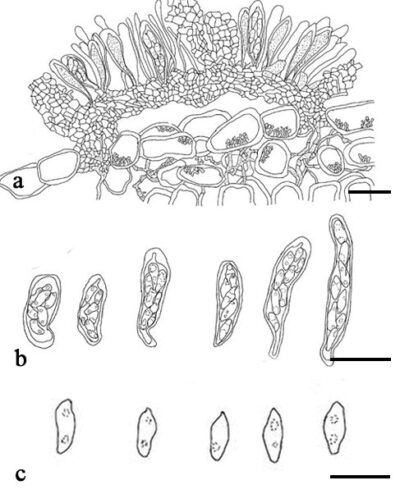Fungalpedia – Note 363, Rhagadolobiopsis
Rhagadolobiopsis Guatimosim & R. W. Barreto
Citation when using this data: Tibpromma et al. 2024 (in prep.) – Fungalpedia, Fungal pathogens.
Index Fungorum, Facesoffungi, MycoBank, GenBank, Fig. 1
Classification: Parmulariaceae, Asterinales, Dothideomycetidae, Dothideomycetes, Pezizomycotina, Ascomycota, Fungi
The monotypic genus Rhagadolobiopsis (Parmulariaceae) was established by Guatimosim et al. (2014), typified by Rhagadolobiopsis thelypteridis, which causes tar spot-like symptoms in the leaves of fern (Thelypteris serrata) and internal mycelium, which are intracellular and intercellular. The sexual morph of Rhagadolobiopsis is similar to that of Rhagadolobium (Parmulariaceae); however, Rhagadolobiopsis differs in multiloculate, superficial, open ascomata, a hymenial gel that does not become blue with iodine. Guatimosim et al. (2014) offered detailed photo plates of digital photos and hand drawings. This species is characterized by haustoria coralloid, stromata, circular to oblong or ellipsoidal, black, multiloculate ascomata, cylindrical-clavate to clavate, non-amyloid, eight-spored asci, colorless, aseptate, fusiform, biguttulate ascospores. However, the asexual morph of Rhagadolobiopsis is still unknown.
Type species: Rhagadolobiopsis thelypteridis Guatim. & R.W. Barreto
Other accepted species: This genus is monotypic.
Figure 1 – Morphology of Rhagadolobiopsis . a Vertical section showing superficial ascoma. b Mature bitunicate asci. c Hyaline ejected ascospores. Scale bars: a, b = 20 μm, c = 10 μm. Redrawn from Guatimosim et al. (2014).
Reference
Entry by
Yang EF, Department of Biology, Faculty of Science, Chiang Mai University, Chiang Mai 50200, Thailand; Center for Yunnan Plateau Biological Resources Protection and Utilization, College of Biological Resource and Food Engineering, Qujing Normal University, Qujing, Yunnan 655011, China.
(Edited by Saowaluck Tibpromma, Samaneh Chaharmiri-Dokhaharani, & Achala R. Rathnayaka)
Published online 14 November 2024
